You are here
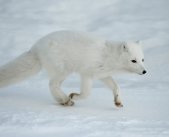
Arctic Fox
The arctic fox is a common sight in the arctic tundra region surrounding Churchill. Their colouring changes with the seasons, turning brown or grey in summer months and white in winter to blend into the surrounding snow.
Their average lifespan in the wild is 3 – 6 years. They can weigh between 6 to 17 lbs. Female arctic foxes give birth each spring to litters as large as 14 pups.
Arctic foxes hunt rodents, birds and even fish in the summer. In the winter when prey is scarce they will follow the trail of a polar bear and scavenge from the larger predator’s kills.
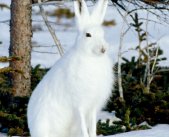
Arctic Hare
Similar to the arctic fox, the arctic hare’s fur is a stark white in winter months, but changes to a blue-grey in summer to aid in camouflage. The arctic hare thrives in the harsh environment of the tundra thanks to several behavioural and physiological adaptations. Their thick white fur helps the hares to conserve heat while their habits of huddling and digging shelters into the snow offers protection from the elements.
The average lifespan of an arctic hare is estimated to be around 5 years. Females give birth to one litter of 2 to 8 babies per year in spring or early summer. By fall the young resemble their parents.
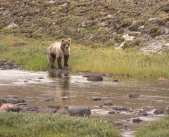
Barren Ground Grizzly
Grizzly bears are the second largest carnivores after the polar bear and are recognizable from the large hump on their shoulders. The barren ground grizzly, found in the Kivalliq region and in large portions of the Kitikmeot and Baffin regions of Nunuvit, is generally smaller and lighter in colour than those found further south.Adult males and females can be anywhere between 146 and 382kg and measure an average of 2.6m in length. They are at their largest in the fall before entering their dens and leanest in the spring when they emerge from their dens.
Grizzlies are omnivorous. Some studies show that caribou are a very important food source for barren ground grizzlies. They appear to hunt them often during the spring, and from midsummer to autumn.
The breeding season for grizzlies is generally late spring to early summer. In Nunavut, female grizzlies usually have their first litter at 8 years of age. Compared to other grizzly populations, this is quite late and makes barren ground grizzlies more sensitive to over-harvesting.
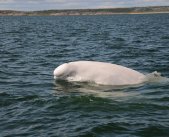
Beluga Whale
Beluga whales are often called the ‘canary of the sea’ because of their wide range of vocalizations. An incredibly curious mammal, they are very social creatures that communicate with members of their pod in a diversified language of clicks, whistles and clangs. They are also known to mimic others sounds they hear.
Some 50,000 beluga whales migrate into the Hudson Bay and the series of rivers that drain into the Bay each July and August in order to feed, give birth and to shed their outer most layer of skin. As of yet, it is unknown where belugas spend the rest of their year, but recently an initiative, which saw a handful of the whales tagged, was launched in order to answer these questions.
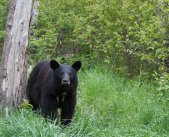
Black Bears
Black bears are North America's most familiar and common bears. They typically live in forests and are excellent tree climbers. Despite their name, black bears can be blue-gray or blue-black, brown, cinnamon, or even (very rarely) white. The average life span of a black bear in the wild is 20 years, and they can weigh between 200 and 600 lbs.
Black bears are very opportunistic eaters. Most of their diet consists of grasses, roots, berries, and insects. They will also eat fish and mammals—including carrion—and easily develop a taste for human foods and garbage. Bears who become habituated to human food at campsites, cabins, or rural homes can become dangerous and are often killed—thus the frequent reminder: Please don't feed the bears!
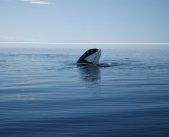
Bowhead Whale
Bowhead whales live exclusively in the arctic at the surface of the ocean. In spring, small pods of whales migrate north to waters that are rich with nutrients; in the fall it is common to see pods as large as 50 whales return to southern arctic waters to breed and calve. Bowhead whales get their name from their large bow-shaped head that accounts for 40% of its body length. A newborn calf is about 17 ft long and weighs roughly 5 – 6 tons. Full-grown whales grow to about 50 – 60 feet and 80 – 110 tons.
Bowhead whales are considered an endangered species; it is estimated that there are roughly 8,000-12,000 bowhead whales worldwide.
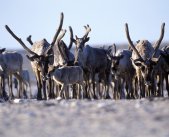
Caribou
Caribou, also known as reindeer, are found in the northernmost regions of North America, Europe, Asia and Greenland. Caribou live an average of 15 years in the wild, and can weigh between 240 to 700 lbs. They are considered an endangered species.
Caribou migrate up to 2,500 km annually. As summer approaches, herds of caribou head north to feed on the abundant grasses and plants of the tundra. An adult caribou can eat up to 12lbs of food each day. As the temperature falls and snow begins to fly, the caribou turn back south to spend their winters in more sheltered areas, where they feed on lichens to survive.

Grizzly Bear
The grizzly bear is a North American subspecies of the brown bear. They have an average lifespan of 25 years in the wild and can weigh up to 800 lbs. Grizzlies are typically brown, though their fur can appear to be white-tipped, or grizzled, lending them their traditional name.
These awe-inspiring giants tend to be solitary animals but at times they do congregate. In the summer, dozens of bears may gather to feast on spawning salmon along the coast of British Columbia and Alaska.
Grizzlies are powerful, top-of-the-food-chain predators. While much of their diet consists of nuts, berries, leaves, and roots they may also eat other animals, from rodents to moose.
Despite their impressive size, grizzlies are quite fast and have been clocked at 30 miles (48 kilometers) an hour. They can be dangerous to humans, particularly if surprised or if humans come between a mother and her cubs.
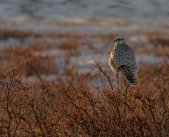
Gyrfalcon
The gyrfalcon is found throughout the arctic and subarctic, on Greenland, North America, Iceland and Russia. It is the furthest north breeding raptor. Gyrfalcons are truly an exciting find, and although a rare sight, there are a couple of spots in the wildlife management area that are more common than others. Tower one, and a large boulder on a hill at the intersection of three trails are both places one might find a hungry gyrfalcon scanning for prey.
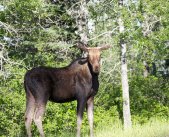
Moose
Moose are the largest of all the deer species. Males are immediately recognizable by their huge antlers, which can spread 6 feet (1.8 meters) from end to end. They can live 15 to 20 years in the wild and weigh up to 1,800 lbs.
Moose are so tall that they prefer to browse higher grasses and shrubs because lowering their heads to ground level can be difficult. In winter they eat shrubs and pinecones. In summer, moose are often seen in lakes, rivers, or wetlands, feeding on aquatic plants both at and below the surface.
Females give birth to one or two calves in the spring. These calves grow quickly and can outrun a person by the time they are just five days old. Young moose stay with their mothers until the following mating season.
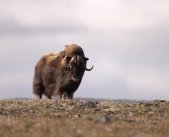
Musk Ox
Musk oxen have an average lifespan of 20 years in the wild, living off roots, mosses and lichen. A full-grown musk ox can weigh between 500 to 800 lbs and stand from 4 to 5 feet at the shoulder.
Musk oxen have inhabited the arctic tundra for thousands of years. Their long shaggy coat is well adapted to the frigid temperatures of the northern climate. The outer hairs, called guard hairs, cover an undercoat that provides insulation in winter. In the summer months, this undercoat is shed.
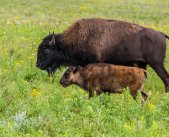
Plains Bison
Bison, symbolic animals of the Great Plains, are often mistakenly called buffaloes. By any name, they are formidable beasts and the heaviest land animals in North America. In the wild, these incredible herbivores can live an average of 12 to 20 years.
Bison once covered the Great Plains and much of North America, and were critically important to Plains Indian societies. During the 19th century, settlers killed some 50 million bison for food, sport, and to deprive Native Americans of their most important natural asset. The once enormous herds were reduced to only a few hundred animals.
Currently, Riding Mountain National Park in central Manitoba is home to a captive herd of plains bison that were introduced into the area after decades of absence. Their re-introduction is just one step in restoring and protecting the prairie ecosystem. The approximately 30 bison that roam the enclosure today are descendants of a small group brought from Elk Island National Park.
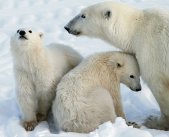
Polar Bear
Polar bears area amongst the largest land mammals in North America. Ranging from 900 to 1,600 lbs, a full-grown bear can measure up to 8 feet tall. The current overall estimate of wild polar bear population is approximately 20,000 – 25,000 worldwide. Roughly 2/3 of that number (15,000) are in Canada.
Churchill, known as the polar bear capital of the world, sees polar bears as early as July, but it is most common to see larger numbers of bears in October and November. This is due largely to the fact that the winter ice in Hudson Bay begins to melt in late June, forcing the bears back on land. The bears then migrate slowly along the coast towards the Churchill area, waiting for the ice to reform in late November. Once the ice is thick enough, the bears return back to the ice to hunt seals in order to restock the fat stores they used during the summer months – polar bears generally don’t hunt at all during the summer and depend on fat stores gained throughout the winter to sustain them.
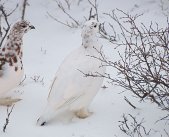
Ptarmigan
Ptarmigan have three seasonal plumages per year that keep them well-camouflaged at all times, instead of the two that are usual for most birds. They are white in winter, brown in summer, and a mix of brown and white in spring and fall. Ptarmigan have feathered feet that help them to walk in snow and weigh between 400-800g.
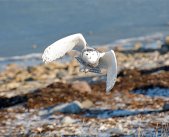
Snowy Owl
Snowy owls that have summered near Churchill or further north begin to migrate south to the prairies in the early to late fall, thus they may be a rare sighting depending on the timing of your visit. During winter snowy owls inhabit prairies, marshes, open fields, or shorelines, habitats that resemble the treeless tundra of their breeding grounds. The owls spend much of their time perched on a vantage point, scanning the area, ready to chase another owl from the territory or to launch a silent attack on their prey. In Churchill, it may eat arctic hares, ptarmigan, or seabirds when available, but its primary prey is lemmings. It must capture the equivalent of 7 to 12 mice per day, or as many as 350 per month, to meet its food requirements. As a result, the population size of snowy owls is linked with the cyclical lemming population, further complicating the chances of sighting this majestic bird.

Walrus
Walruses are large seal-like animals with dark brown skin and long tusks. They can grow to an average of 3,000 lbs and live up to 40 years in the wild.Walruses spend most of their lives on land. The live in shallow waters, but are able to dive up to 90 metres and stay underwater for up to 30 minutes while hunting.
There is an estimated 300,000 walrus worldwide split into two subspecies – the Atlantic walrus, of which there is an estimated 20,000 and the Pacific walrus estimated at 280,000. The largest known herd of walrus (approximately 5,000) is in Foxe Basin, Nunavut.